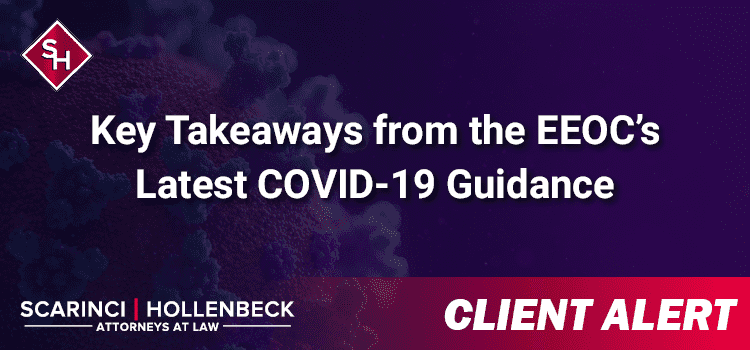
Scarinci Hollenbeck, LLC
The Firm
201-896-4100 info@sh-law.comAuthor: Scarinci Hollenbeck, LLC|April 17, 2020
For New York and New Jersey employers looking for guidance on how to handle the risk of coronavirus (COVID-19) in the workplace, the Equal Employment Opportunity Commission (EEOC) is answering some common questions. The latest EEOC guidance, entitled “What You Should Know About COVID-19 and the ADA, the Rehabilitation Act, and Other EEO Laws,” addresses issues ranging from screening workers for the virus and addressing workplace harassment. Below are a few key takeaways.

The Americans with Disabilities Act (ADA), which applies to employers with 15 or more employees, includes rules about employer medical examinations and inquiries. As the EEOC explains, during a pandemic, ADA-covered employers may ask employees if they are experiencing symptoms of COVID-19, which may include fever, chills, cough, shortness of breath, or sore throat. The EEOC also acknowledges that our understanding of the coronavirus continues to evolve. Accordingly, it advises that “employers should rely on the CDC, other public health authorities, and reputable medical sources for guidance on emerging symptoms associated with the disease.” These sources may guide employers when choosing questions to ask employees to determine whether they would pose a direct threat to health in the workplace.
The EEOC guidance also addresses temperature checks, which many businesses are employing in an effort to identify sick employees. The EEOC advises that measuring an employee’s body temperature is typically considered a medical examination. However, because the CDC and state/local health authorities have acknowledged community spread of COVID-19 and issued attendant precautions, employers may measure employees’ body temperature (with the caveat that some people with COVID-19 do not have a fever).
The EEOC also confirms that employers may screen job applicants for symptoms of COVID-19 after making a conditional job offer, as long as it does so for all entering employees in the same type of job. Employers may also delay the start date for a prospective worker that has COVID-19 or symptoms associated with it.
The EEOC guidance also addresses the steps employers must take to maintain the confidentiality of employee medical information, as required under the ADA. As noted by the EEOC, the ADA requires that all medical information about a particular employee be stored separately from the employee’s personnel file.
An employer may store all medical information related to COVID-19 in existing medical files, which includes an employee’s statement that he has the disease or suspects he has the disease, or the employer’s notes or other documentation from questioning an employee about symptoms. If an employer requires all employees to have a daily temperature check before entering the workplace, the employer needs to maintain the confidentiality of this information as well.
In some cases, disclosure of COVID-19 medical information is permissible. For instance, an employer can disclose the name of an employee to a public health agency when it learns that the employee has COVID-19. In addition, a staffing agency or contractor may notify the employer and disclose the name of the employee, because the employer may need to determine if this employee had contact with anyone in the workplace.
The EEOC guidance also addresses issues related to accommodating employees during the pandemic. It notes that while many people feel significant stress due to the COVID-19 pandemic, employees with certain preexisting mental health conditions, for example, anxiety disorder, obsessive-compulsive disorder, or post-traumatic stress disorder, may have more difficulty handling the disruption to daily life that has accompanied the COVID-19 pandemic. According to the EEOC, as with any accommodation request, employers may: ask questions to determine whether the condition is a disability; discuss with the employee how the requested accommodation would assist him and enable him to keep working; explore alternative accommodations that may effectively meet his needs; and request medical documentation if needed.
The EEOC also addresses reasonable accommodations for individuals who are at higher risk from COVID-19 due to a preexisting disability but have jobs that can only be performed at the workplace. “Even with the constraints imposed by a pandemic, some accommodations may meet an employee’s needs on a temporary basis without causing undue hardship on the employer,” the guidance states.
“Low-cost solutions achieved with materials already on hand or easily obtained may be effective,” the EEOC states. “If not already implemented for all employees, accommodations for those who request reduced contact with others due to a disability may include changes to the work environment such as designating one-way aisles; using plexiglass, tables, or other barriers to ensure minimum distances between customers and coworkers whenever feasible per CDC guidance or other accommodations that reduce chances of exposure.”
The EEOC also highlights that flexibility by employers and employees alike needed to determine what accommodation may be available. “Temporary job restructuring of marginal job duties, temporary transfers to a different position, or modifying a work schedule or shift assignment may also permit an individual with a disability to perform safely the essential functions of the job while reducing exposure to others in the workplace or while commuting,” the guidance advises.
As employers should be aware, Title VII of the Civil Rights Act prohibits discrimination based on race, color, national origin, religion, and sex, including pregnancy. In its guidance, the EEOC advises that employers can help reduce the chance of harassment by explicitly communicating to the workforce that fear of the COVID-19 pandemic should not be misdirected against individuals because of a protected characteristic, including their national origin, race, or other prohibited bases.
If you have any questions or if you would like to discuss the matter further, please contact me, Maryam Meseha, or the Scarinci Hollenbeck attorney with whom you work, at 201-896-4100.

The Firm
201-896-4100 info@sh-law.comFor New York and New Jersey employers looking for guidance on how to handle the risk of coronavirus (COVID-19) in the workplace, the Equal Employment Opportunity Commission (EEOC) is answering some common questions. The latest EEOC guidance, entitled “What You Should Know About COVID-19 and the ADA, the Rehabilitation Act, and Other EEO Laws,” addresses issues ranging from screening workers for the virus and addressing workplace harassment. Below are a few key takeaways.

The Americans with Disabilities Act (ADA), which applies to employers with 15 or more employees, includes rules about employer medical examinations and inquiries. As the EEOC explains, during a pandemic, ADA-covered employers may ask employees if they are experiencing symptoms of COVID-19, which may include fever, chills, cough, shortness of breath, or sore throat. The EEOC also acknowledges that our understanding of the coronavirus continues to evolve. Accordingly, it advises that “employers should rely on the CDC, other public health authorities, and reputable medical sources for guidance on emerging symptoms associated with the disease.” These sources may guide employers when choosing questions to ask employees to determine whether they would pose a direct threat to health in the workplace.
The EEOC guidance also addresses temperature checks, which many businesses are employing in an effort to identify sick employees. The EEOC advises that measuring an employee’s body temperature is typically considered a medical examination. However, because the CDC and state/local health authorities have acknowledged community spread of COVID-19 and issued attendant precautions, employers may measure employees’ body temperature (with the caveat that some people with COVID-19 do not have a fever).
The EEOC also confirms that employers may screen job applicants for symptoms of COVID-19 after making a conditional job offer, as long as it does so for all entering employees in the same type of job. Employers may also delay the start date for a prospective worker that has COVID-19 or symptoms associated with it.
The EEOC guidance also addresses the steps employers must take to maintain the confidentiality of employee medical information, as required under the ADA. As noted by the EEOC, the ADA requires that all medical information about a particular employee be stored separately from the employee’s personnel file.
An employer may store all medical information related to COVID-19 in existing medical files, which includes an employee’s statement that he has the disease or suspects he has the disease, or the employer’s notes or other documentation from questioning an employee about symptoms. If an employer requires all employees to have a daily temperature check before entering the workplace, the employer needs to maintain the confidentiality of this information as well.
In some cases, disclosure of COVID-19 medical information is permissible. For instance, an employer can disclose the name of an employee to a public health agency when it learns that the employee has COVID-19. In addition, a staffing agency or contractor may notify the employer and disclose the name of the employee, because the employer may need to determine if this employee had contact with anyone in the workplace.
The EEOC guidance also addresses issues related to accommodating employees during the pandemic. It notes that while many people feel significant stress due to the COVID-19 pandemic, employees with certain preexisting mental health conditions, for example, anxiety disorder, obsessive-compulsive disorder, or post-traumatic stress disorder, may have more difficulty handling the disruption to daily life that has accompanied the COVID-19 pandemic. According to the EEOC, as with any accommodation request, employers may: ask questions to determine whether the condition is a disability; discuss with the employee how the requested accommodation would assist him and enable him to keep working; explore alternative accommodations that may effectively meet his needs; and request medical documentation if needed.
The EEOC also addresses reasonable accommodations for individuals who are at higher risk from COVID-19 due to a preexisting disability but have jobs that can only be performed at the workplace. “Even with the constraints imposed by a pandemic, some accommodations may meet an employee’s needs on a temporary basis without causing undue hardship on the employer,” the guidance states.
“Low-cost solutions achieved with materials already on hand or easily obtained may be effective,” the EEOC states. “If not already implemented for all employees, accommodations for those who request reduced contact with others due to a disability may include changes to the work environment such as designating one-way aisles; using plexiglass, tables, or other barriers to ensure minimum distances between customers and coworkers whenever feasible per CDC guidance or other accommodations that reduce chances of exposure.”
The EEOC also highlights that flexibility by employers and employees alike needed to determine what accommodation may be available. “Temporary job restructuring of marginal job duties, temporary transfers to a different position, or modifying a work schedule or shift assignment may also permit an individual with a disability to perform safely the essential functions of the job while reducing exposure to others in the workplace or while commuting,” the guidance advises.
As employers should be aware, Title VII of the Civil Rights Act prohibits discrimination based on race, color, national origin, religion, and sex, including pregnancy. In its guidance, the EEOC advises that employers can help reduce the chance of harassment by explicitly communicating to the workforce that fear of the COVID-19 pandemic should not be misdirected against individuals because of a protected characteristic, including their national origin, race, or other prohibited bases.
If you have any questions or if you would like to discuss the matter further, please contact me, Maryam Meseha, or the Scarinci Hollenbeck attorney with whom you work, at 201-896-4100.